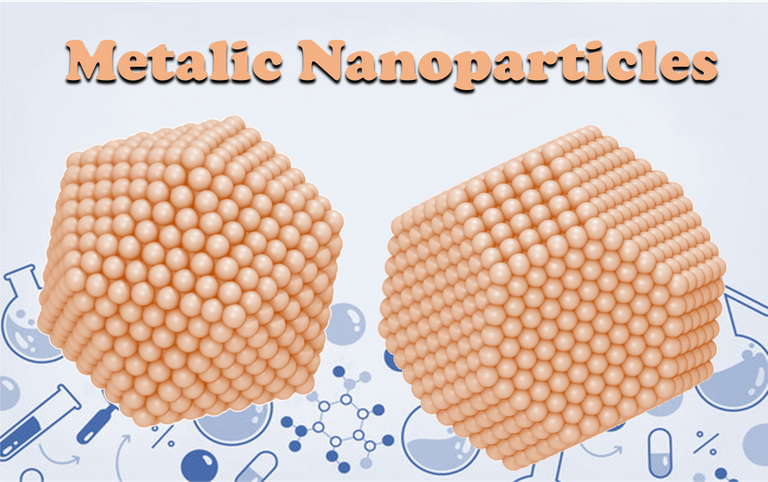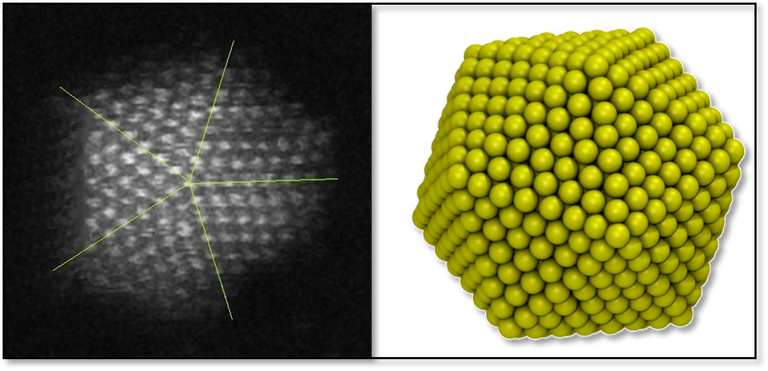Into the wonderful nanoworld: metallic nanoparticles / Dentro del maravilloso nanomundo: nanopartículas metálicas [ESP/ENG]

Bienvenido al nanomundo / Welcome to the nanoworld
Hola comunidad, seguro han escuchado hablar alguna vez de las nanopartículas metálicas como las de plata u oro, pero alguna vez se han preguntado: ¿qué forma tienen?, ¿cuáles son sus propiedades o cuáles son sus aplicaciones? Si quieres conocer más sobre la nanotecnología y cuan impresionantes pueden ser los aportes al avance de la ciencia, este post es para ti.
Hello community, surely you have heard about metallic nanoparticles such as silver or gold, but have you ever wondered: what is their shape, what are their properties or what are their applications? If you want to know more about nanotechnology and how impressive can be the contributions to the advancement of science, this post is for you.

Los metales y la nanotecnología / Metals and nanotechnology
Los metales han sido materiales de gran interés desde los inicios de la ciencia, mediante años de investigaciones, se han podido identificar sus propiedades fisicoquímicas, las cuales son de gran interés para las ciencias básicas y las ciencias aplicadas. Ahora bien, con la llegada de la nanotecnología se ha empezado a trabajar con este y otro tipo de materiales a escalas nanométricas, haciendo que estos tengan un comportamiento diferente en cuanto a sus propiedades con respecto a un material masivo, por ejemplo: un simple pedazo de cobre. Por lo que una nanopartícula metálica, al ser más pequeña tendrá una mayor área superficial, incrementado la fracción de átomos en su superficie, lo que altera significativamente sus propiedades fisicoquímicas, por lo que un diseño inteligente de estos nanomateriales es de gran interés para diferentes áreas como la energía renovable o la biomedicina.
Metals have been materials of great interest since the beginning of science, through years of research, it has been possible to identify their physicochemical properties, which are of great interest for basic and applied sciences. Now, with the advent of nanotechnology has begun to work with this and other materials at nanoscale, making these have a different behavior in terms of their properties with respect to a massive material, for example: a simple piece of copper. Therefore, a metallic nanoparticle, being smaller, will have a larger surface area, increasing the fraction of atoms on its surface, which significantly alters its physicochemical properties, so that an intelligent design of these nanomaterials is of great interest for different areas such as renewable energy or biomedicine.
¿Has visto alguna vez una nanopartícula metálica? / Have you ever seen a metallic nanoparticle?
Las nanopartículas metálicas pueden ser de diferentes metales (incluso mezclas de metales), tamaños o formas, lo cual por supuesto hace variar sus propiedades y dependiendo de sus aplicaciones se escoge el tipo de nanopartícula que se necesita sintetizar. El propósito de este post es ilustrar sobre este mundo a nano escala y mostrar una de las formas más comunes de estas nanopartículas. En la siguiente figura, a la izquierda se puede ver la imagen capturada por un microscopio electrónico de transmisión (TEM) de una nanopartícula de oro con una forma icosaédrica (una de las formas más comunes encontradas experimentalmente) y a la derecha se encuentra una nanopartícula de la mismo forma diseñada y renderizada en VMD (un software de visualización de moléculas ), en la que se puede ver con detalle la configuración de los átomos.
Metallic nanoparticles can be of different metals (even mixtures of metals), sizes or shapes, which of course makes their properties vary and depending on their applications the type of nanoparticle that needs to be synthesized is chosen. The purpose of this post is to illustrate this nanoscale world and to show one of the most common forms of these nanoparticles. In the following figure, on the left you can see the image captured by a transmission electron microscope (TEM) of a gold nanoparticle with an icosahedral shape (one of the most common shapes found experimentally) and on the right is a nanoparticle of the same shape designed and rendered in VMD (a molecule visualization software), in which you can see in detail the configuration of the atoms.

¿Dónde se pueden aplicar? / Where can they be applied?
Las nanopartículas metálicas, son componentes esenciales en los sistemas de almacenamiento y conversión de energía, actualmente de gran importancia para el futuro energético del planeta. Por otro lado, son fundamentales en la construcción de biosensores capaces de detectar enfermedades, así como también se pueden encontrar en la aplicación dirigida de algunos fármacos. Estas y otras muchas aplicaciones pueden tener las NPs, siendo muy importantes para la industria energética y la biomedicina.
Metallic nanoparticles are essential components in energy storage and conversion systems, currently of great importance for the energy future of the planet. On the other hand, they are fundamental in the construction of biosensors capable of detecting diseases, as well as they can also be found in the targeted application of some drugs. These and many other applications can have the NPs, being very important for the energy industry and biomedicine.

Consideraciones finales / Final Considerations
La manipulación de la materia a escala nanométrica todavía esconde muchas cosas sin resolver. Sin embargo, actualmente podemos decir que existe un gran avance en cuanto a las investigaciones, las síntesis y aplicaciones de las nanopartículas metálicas, las cuales hoy son empleadas en muchas ramas de la ciencia con gran éxito. Espero que les haya gustado este post sobre este mundo nanométrico. ¡Nos vemos a la próxima!
The manipulation of matter at the nanometer scale still hides many unresolved issues. However, nowadays we can say that there is a great progress in terms of research, synthesis and applications of metallic nanoparticles, which today are used in many branches of science with great success. I hope you liked this post about this nanometric world, see you next time!

The first image is mine, I made the collage of the following images in Gimp.
